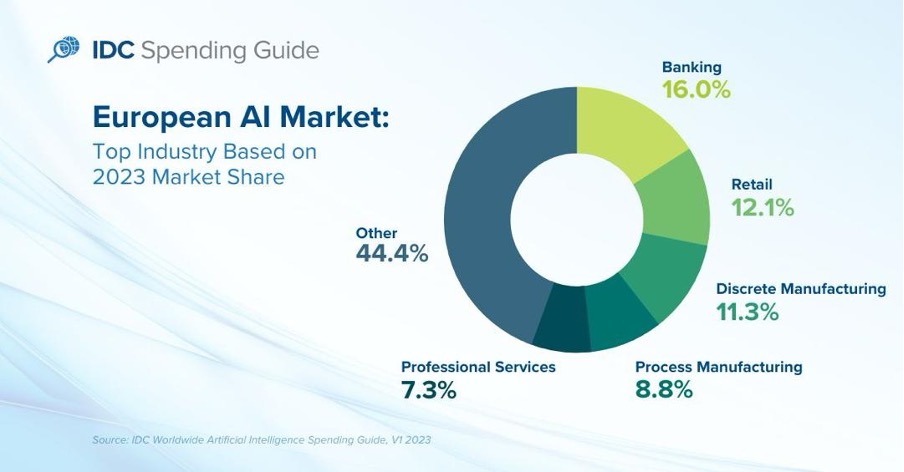Manufacturing Commerce 2024: What to Expect
When we think about the future, high-tech visions often come to mind. Yet, the true mark of advancement lies not in the technology itself but in its ability to blend seamlessly into our daily routines—like self-driving cars or robot vacuums that operate quietly in the background.
Can B2B ecommerce be just as autonomous? Not yet, but this is where marketers are headed in 2024.

Manufacturing sector: where are we now?
When one considers the myriad of problems facing the manufacturing world, particularly in Europe, there's a temptation to be pessimistic. Regional conflicts and increased demands have led to rising energy prices, the labour shortage problem persists, and the regulatory hurdles are getting tougher to scale.
However, the European manufacturing industry continues to show resilience. Industrial production went up by 8% in 2021 and 5% in 2022. The future outlook is just as encouraging.
Statista projects that the value added in the European manufacturing market will reach $3.06 trillion in 2024 and a compound annual growth rate between 2024 and 2028 to hit 3.71%, exceeding regions like America (3.08%) and Asia (3.70%).
What are the factors contributing to this anticipated growth in manufacturing? How is the industry preparing to overcome challenges, past and present?
Read on for an overview of the emerging trends shaping manufacturing commerce 2024 to be a promising business year.
5 trends shaping manufacturing commerce in 2024
1. Strategic adoption of advanced technologies.
Technological advancements have been creeping into manufacturing commerce for years now. In 2024, we expect higher adoption rates for some of the best tech innovations, which will fuel the industry's growth.
Artificial Intelligence (AI) is obviously at the forefront of these innovations. According to IDC, the manufacturing industry was responsible for a large portion of European AI market spending in 2023. AI rewarded investors by revolutionizing processes everywhere, from the production floor to product marketplaces.

The journey towards smart factories is well underway, and AI is poised to fast-track that process. Adding the vast computational power of AI to the Internet of Things (IoT), 5G, and cloud computing, manufacturers will now be able to design highly efficient, interconnected, and data-driven factories in 2024.
That means more predictive maintenance, higher productivity, and lower production costs.
More to the customer-facing aspects, AI will give manufacturers the option to automate customer support, marketing, and sales with:
- AI-powered self-service portals
- GenAI-driven content production
- Hyper-personalised product descriptions
- Smarter use of dynamic pricing
2. Rebuilding supply chain resilience
The COVID-19 pandemic caused significant supply chain disruptions, and geopolitical instability continues to strain the chain. Consequently, industry leaders will focus on returning the supply chain to its glory days of efficiency.
In a bid to ensure supply chain autonomy and resilience, manufacturers are exploring digital solutions. Two such exciting solutions include digital twin and Blockchain technology, boosting future commerce growth.
Digital twin technology provides virtual models of assets, processes, and systems within the supply chain. This confers the benefits of real-time monitoring, risk identification, and enhanced end-to-end visibility within the supply chain. Therefore, manufacturers can predict disruptions and risks and make smarter decisions to ensure products get to customers' hands on time, every time.
Blockchain technology, on the other hand, promises supply chain technology and security. By providing a decentralized ledger for transactions, every step, from raw material procurement to product delivery, will be verifiable and tamper-proof. Such transparency reduces fraud, fortifies trust, and improves compliance, all crucial to supply chain networks.
These technologies not only ensure product delivery reliability but also open new opportunities for ecommerce platforms to enhance transparency and trust with customers.
3. The rise of aftermarket services
The deeper we go into the post-pandemic age, the more sense it makes for manufacturers of durable goods to offer aftermarket services. Not only do these services boost customer loyalty and strengthen business relationships, they could be a great source of revenue and profits for the manufacturers.
Some aftermarket services to expect from manufacturing commerce key players in 2024 include maintenance services, end-user training, and spare parts provision. We can also expect to see more exciting services like remote diagnostics. Here, manufacturers will utilize IoT, AI, and advanced data analytics to troubleshoot problems or facilitate predictive maintenance services.
Considering the immense benefits to manufacturers and their customers, aftermarket service is a strategy that will dominate future commerce practices from 2024 and beyond.
4. The push towards sustainable manufacturing
In 2024, more European companies will prioritize sustainability in their manufacturing processes. This trend stems from external pressures to protect the environment and the increasing realization that adopting sustainable practices is key to future competitiveness.
For the longest time, the argument against sustainability has been that manufacturers and consumers are not on the same page regarding sustainable products. However, 59% of executives say they are incorporating sustainable materials in their production process. With 90% of consumers willing to pay an extra 10% for sustainable products, it's clear both parties are thinking alike.
This trend is especially relevant for ecommerce, as platforms become key channels for communicating a brand's commitment to sustainability.
By highlighting eco-friendly production processes and materials online, manufacturers will align with consumer values, fostering loyalty and potentially commanding higher prices for sustainable products.
5. The growth of D2C models in European manufacturing
As of 2022, 13% of the world's direct-to-consumer (D2C) brands were in Europe. In manufacturing commerce in 2024, we can expect this particularly advantageous business model to gain more traction on the continent.
Manufacturing companies all over the world are leveraging digital platforms, including social media, websites, and apps, to open direct lines of communication with consumers, cutting out intermediaries in the process. The first obvious advantage is that this practice will shorten the supply chain and thereby lower costs, boost efficiency, and optimize production planning.
Perhaps an even bigger address of the D2C model is the immense opportunities for personalization that come with it. By directly engaging customers, manufacturers generate a wealth of data on consumer behaviour, preferences, and trends. Such insights allow data-driven decisions on product development and marketing strategies.
Practising the D2C model opens up new revenue streams and ensures businesses can remain competitive in the ever-evolving European industry.
A bright horizon for manufacturing commerce
The European manufacturing sector stands at the cusp of transformative growth, driven by strategic technology integration, supply chain innovation, service expansion, sustainability efforts, and direct consumer engagement. These trends underscore the industry’s adaptability and potential for sustained growth amidst challenges.
For more insights into this ever-evolving industry, subscribe to our newsletter curated by industry experts.